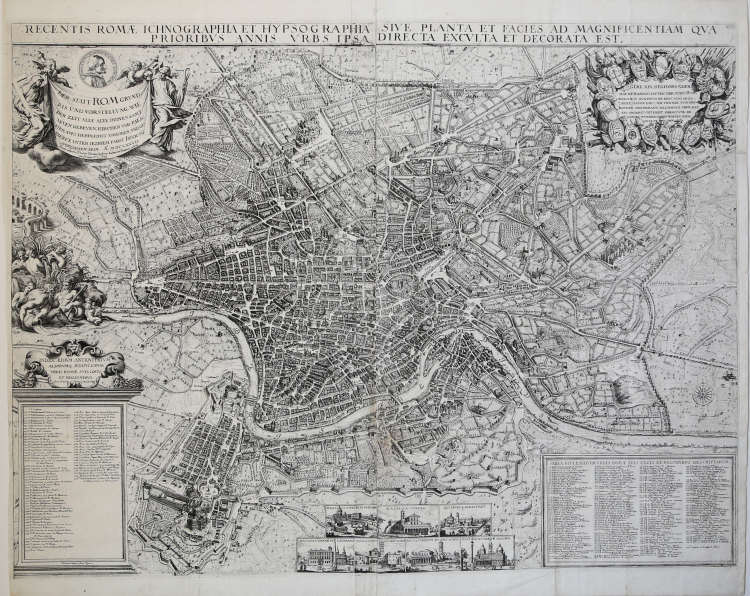



| Reference: | MMS1734 |
| Author | Joachim von SANDRART |
| Year: | 1677 |
| Zone: | Rome |
| Printed: | Nurnberg |
| Measures: | 860 x 650 mm |


| Reference: | MMS1734 |
| Author | Joachim von SANDRART |
| Year: | 1677 |
| Zone: | Rome |
| Printed: | Nurnberg |
| Measures: | 860 x 650 mm |
Large plan of the city, printed on two real sheets, copy of the one made by Giovan Battista Falda in 1667 for Pope Alexander VII.
Mixed projection map, oriented with north on the left. Topographically, Sandrart's map is faithful to Falda's; the substantial changes are in the cartouches, with the German inscriptions, and in the dedication to Pope Innocezo XI. The right-hand cartouche depicts the coats of arms of the Rioni, while small views of the seven Jubilee churches are engraved in the bottom centre.
Engraved by four hands with Johannes Meyer, this plan is more refined in the elegance of its sign than the Falda, carved by the Frenchman Lhuiler.
"Copy of Falda's small plan engraved by Meyer, signed at lower left Iohann Meyer fecit Tiguri. In the upper left corner, instead of the dedication made by Falda to Alexander VII, the dedication to Innocent XI (1676-89) appears with the date 1677 and lower down the name of Ioachini Sandrart. The plan is probably also contained in Sandrart's work Der Alten und neue, published in Nuremberg in 1768' (cf. Marigliani p. 219).
A fresh and bright example of this rare separately issued version of Giovanni Battista Falda’s (1643-78) important 1667 two-sheet plan of Rome (called the pianta piccola). “Falda’s pianta piccola was an instant success: One of the most frequently and enduringly copied maps of the early modern period” (Maier, p. 196), it served as the model for his famed 12-sheet pianta grande (Nuova pianta et alzata della città di Roma) of 1676.
Falda’s design was “widely acclaimed as the most complete and accurate visual record of baroque Rome” (Maier, p. 165). His 12-sheet map “appeared in five editions over a period of eighty years, its celebrity eclipsed only by the appearance of Giovanni Battista Nolli’s great plan in 1748. The original 1667 pianta piccola was indebted to the German etcher Greuter and celebrated the urban interventions of Pope Alexander VII (r. 1655-77). An index along the right side details the pope’s many projects, visible in the fabric of the city, and personifications at the upper left convey the message that under the Chigi pope, Religion had conquered Heresy and Architecture has defeated Time” (McPhee, pp. 8, 10). Inset at the left of this 1667 pianta piccola are personifications of Rome’s water sources and inset at the bottom are views of the Sette Chiese, Rome’s principal pilgrimage churches.
Etching, with margins, in excellent condition. Rare.
Bibliografia
Huelsen (1915): n. 119; Scaccia Scarafoni (1939): n. 200; A. P. Frutaz, Le piante di Roma, CLVI ; TIB p. 317, 281 C1. C. Marigliani, Le Piante di Roma delle collezioni private, tav. 126; S. McPhee, “Falda’s Map as a Work of Art,” The Art Bulletin, vol. 101, no. 2 (2019), pp. 7-28; J. Maier, Rome Measured and Imagined: Early Modern Maps of the Eternal City.
Joachim von SANDRART (Francoforte 1606 - Norimberga 1688)
|
German painter and treatises. Traveled extensively and was the most important German artist of the time but is remembered today almost exclusively for the "Teutsche Academie der Edlen Bau-Bild-und Mahlerey Künste" (German Academy of the noble arts of architecture, sculpture and painting) , published in Nuremberg in 1675-79 and followed by Latin edition in 1683. This treaty, organized into three main sections, is a source of great importance. The first part is an introduction to the art of architecture, painting and sculpture, mainly derived from earlier sources like Vasari and Van Mander. The second part, which contains biographies of artists, uses the same way as material from earlier sources, but also contains new material, especially on German artists and contemporary artists that the author knew personally (including Poussin and Lorrain). The third part contains information on art collections and a survey 'iconography, and finally there is also a chapter on the art of the Far East. Sandrart was the first director (1662) Academy of Nuremberg (the first in Germany).
|
Joachim von SANDRART (Francoforte 1606 - Norimberga 1688)
|
German painter and treatises. Traveled extensively and was the most important German artist of the time but is remembered today almost exclusively for the "Teutsche Academie der Edlen Bau-Bild-und Mahlerey Künste" (German Academy of the noble arts of architecture, sculpture and painting) , published in Nuremberg in 1675-79 and followed by Latin edition in 1683. This treaty, organized into three main sections, is a source of great importance. The first part is an introduction to the art of architecture, painting and sculpture, mainly derived from earlier sources like Vasari and Van Mander. The second part, which contains biographies of artists, uses the same way as material from earlier sources, but also contains new material, especially on German artists and contemporary artists that the author knew personally (including Poussin and Lorrain). The third part contains information on art collections and a survey 'iconography, and finally there is also a chapter on the art of the Far East. Sandrart was the first director (1662) Academy of Nuremberg (the first in Germany).
|